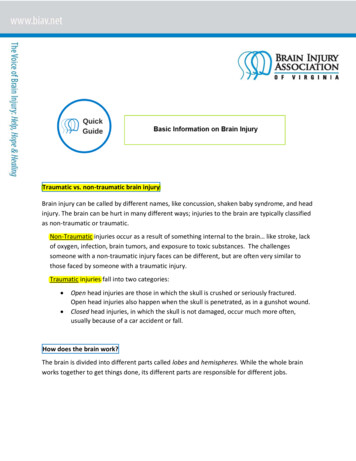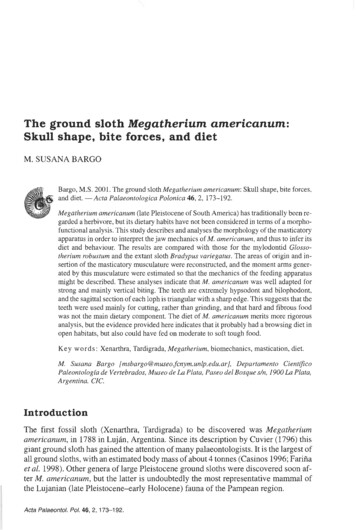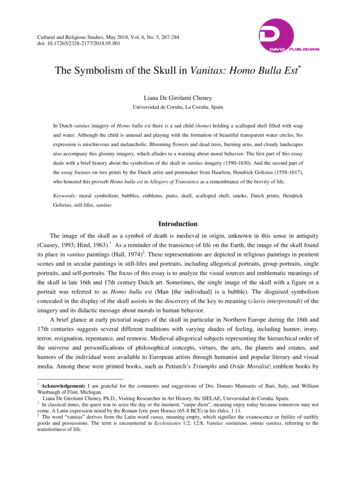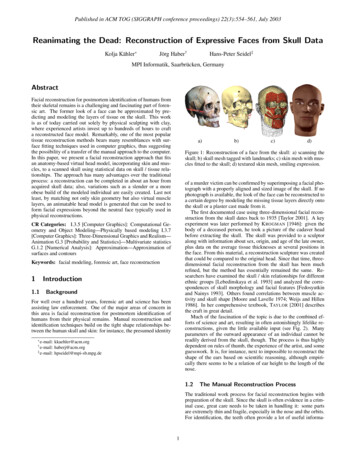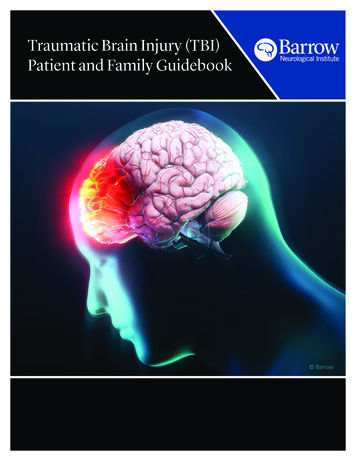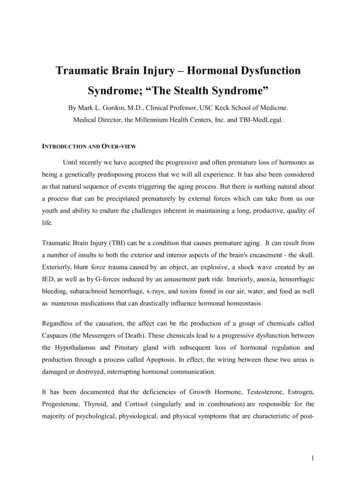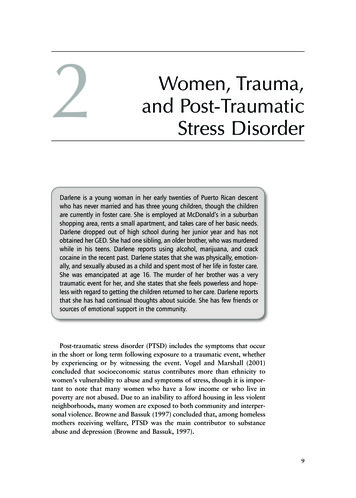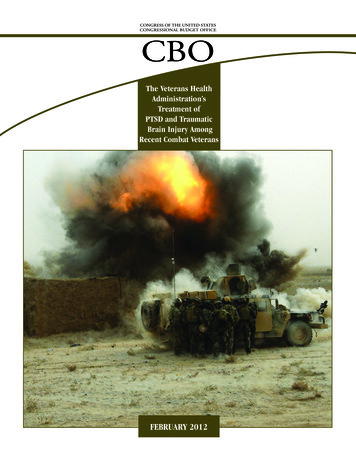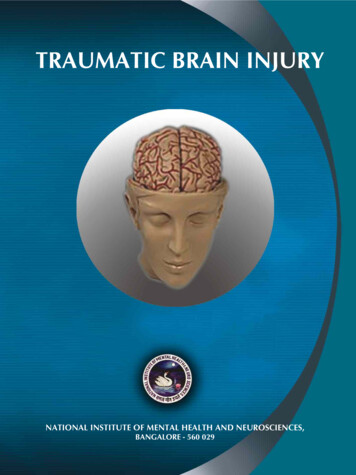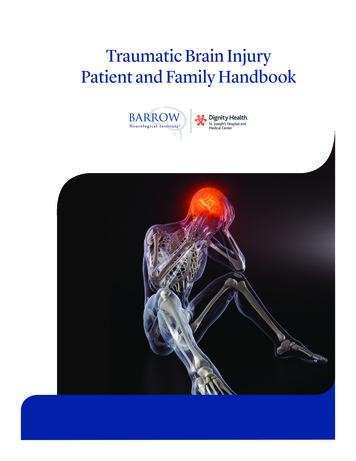
Transcription
A PUBLICATION FOR ALUMNI & FRIENDS OF RUTGERS ROBERT WOOD JOHNSON MEDICAL SCHOOLFA L LTraumaticBrain InjuryLeads toa3-D–PrintedSkull 2 0 17
TheGold Standardin Patient CareWe are proud that the faculty and staff of Rutgers RobertWood Johnson Medical School, a practice division ofRutgers Health, have earned the Gold Seal of Approvalfrom The Joint Commission, the nation’s premier healthcare quality accrediting body. We voluntarily underwentthis rigorous review to be the best that we can be. Withthis internationally recognized award, we join an elitegroup of health care providers across the country.Life is stressful. Trusting a health care provider shouldn’t be.When you select our medical practice, you can be certainthat you and your family will receive the highest quality carein the safest manner.goldseal.rutgershealth.org
LETTERFROMTHEDEANDear Friends,Iam excited to announce that our medical school has been awarded the Joint Commission’s AmbulatoryHealth Care Accreditation. This accreditation is a testament to the high level of quality and safety webring to our patients, and I am incredibly grateful to our faculty and staff who worked tirelessly toimprove our processes. As you will discover in this issue of Robert Wood Johnson Medicine, our dedicationto clinical care is reflected in the successful outcomes of patients in our feature stories.When I first learned about Chris Cahill receiving a 3-D–printed skull, I was captivated by the compellingand unique story (“Traumatic Brain Injury Leads to a 3-D–Printed Skull,” page 16). Gaurav Gupta, MD,assistant professor of neurosurgery, and the division’s commitment toinnovation and delivery of excellent treatment during a complex case areadmirable. This palpable demonstration of care is further exemplified in“Helping Joey’s Life Get Back on an Even Keel” (page 4). Joey and hisfamily spent years visiting physicians with no diagnosis, until he wasreferred to and treated by P. Ashley Wackym, MD, professor and chairof the newly formed Department of Otolaryngology–Head and NeckSurgery. Finally, after revolutionary surgery and treatment, Joey is ableto enjoy being a kid again.Our students continue to do great work inside and outside of theclassroom. Two students and one alumna are accomplished writers withcommitment to patients (“Three Women Need to Write Far More ThanJOHN O’BOYLEa fervor for language and storytelling, which they say complements theirCan Fit on a Prescription Pad,” page 9). I think you will agree after reading the alumi profiles (pages 42–48)that our alumni are using their unique skill sets and interests to pursue exciting and diverse career paths.I hope you are as proud as I am to be a part of Robert Wood Johnson Medical School and share in thishistoric moment in time.Sincerely,Sherine E. Gabriel, MD, MScDeanRobert Wood Johnson MEDICINE 1
Social MediaHIGHLIGHTSFOLLOW US on Facebook, Instagram, and Twitter for News about the Medical School in Real Time!julia tartagliajulia tartagliaEric B Chandler Healt.julia tartaglia I’d like to dedicate my first#medstudentlife to my amazing team atthe Promise Clinic, a RWJMS student-ledfree clinic that serves uninsured patientsin New Brunswick, NJ! So grateful tohave had the opportunity to learn clinicalskills with three great mentors and to getto know my first patient over this pastyear. #medicine #rwjms #promiseclinic#scientista #thisiswhatascientistalookslike#womenin medicine @rwjms #medschool#medschoollifehowtogastro Hey there my fellow doctorto be! I’ve just started up my ownYouTube channel postingGastroenterology related pathologies. Mychannel is called “How to Gastro” pleasecheck it out, subsribe and share. Thankyou very much, it’s much appreciated.rwjmsrwjmsState Theatre New Je.rwjms A view from the stage!Congratulations to the #classof2017!!#rutgers #rwjms #rwjms2017RWJMSRWJMedicalschool18 LikesAPRIL 14rwjmsRWJMS28 LikesrwjmsMAY 15rwjms Flashback to last Friday whenthe Class of 2020 welcomed the Classof 2021 at their White Coat Ceremony#rutgers2021 #rwjmsanya simone @hidef72rwjms@RWJMedicalSchoolRobert Wood Johnson Medical SchoolrwjmsRutgers University - Crwjms Practicing neurosurgery onhard-boiled eggs. #rutgersday#rutgers #rwjms73 LikesAUGUST 11Dr. Richard Agag, chief of the medical school’s division of plasticsurgery, was profiled in this issue of Rutgers Today for his worktraining peers in developing nations -- most recently Nepal, providing trainingin microsurgical techniques. Learn vels./20170709.rwjmsrwjmsrwjms RWJMS alumni and friends#scarletforeverrdgoel That’s my med schoolroommate!Rutgers Surgeon Travels World Training Peers inDeveloping Nations Media RelationsNew Jersey Medical School-trained surgeon, who is an associate professor ofsurgery an the chief of the Division of Plastic Surgery at Rutgers Robert Wood.NEWS.RUTGERS.EDUctinemdctinemdAnastasia the Musical27 LikesSEPTEMBER 17, 2016ctinemd Thank you to the amazingcast of @anastasiabway for spendingsome time discussing #popculture and#medicine with @rwjms faculty andresidents! #bestphotobombever #cme#medicaleducationleelalavida Best advertisement for aresidency program ever!!ctinemd @leelalavida agree 100%with that!39 LikesMAY 2Don’t forgetto tag #RWJMS whenyou post!We want to see whatyou’re up to!Robert Wood Johnson Medical SchoolPremature Infants at Greater Risk of #SIDS. Rutgers Robert Wood JohnsonMedical School researchers Drs. Hegy and Ostfeld say NICU’s need to offermore education before baby goes home. Read more in the link below andlearn the AAP recommendations for safe infant sleep uide-to-Safe-S.Premature Infants at Greater Risk ofSIDS Media RelationsPremature infants still have a greater risk comparedto full-term babies of dying of SIDS and other sleeprelated infant deaths despite recommendations fromthe American Academy of Pediatrics that hospital.NEWS.RUTGERS.EDU
FEATUREContentsHelpingJoey’s LifeGet Back onan Even Keel4After 14-year-old JoeyZarello endured yearsof confusion and misdiagnoses, P. AshleyWackym, MD, diagnosed third window syndrome andperformed surgery that changed Joey’s life.By Lynda RudolphSandra Hill,Eric B.Chandler HealthCenter ExecutiveDirector, BringsPatience and Kindness to the JobThe executive director of the Eric B. Chandler HealthCenter keeps a busy clinic running smoothly and thestaff and patients happy.By Jacqueline Cutler16Three Women Needto Write Far More Than Can Fiton a Prescription PadTwo students and one alumna study medicine yetcontinue to fulfill their lifelong passion for writing.Both fields require the same talents of observation andanalysis, and these women show how each can,ultimately, complement the other.By Jacqueline CutlerTraumaticBrain Injury Leadsto a 3-D–PrintedSkullAfter Chris Cahill spentmonths in and out of consciousness, Gaurav Gupta,MD, performed surgeryusing 3-D printing to create a custom cranial skullimplant for his patient.By Jillian PriorLarger Than Life:Newark Mural HonorsThree Doctors20RobertWoodJohnsonPresidentPaul F. Weber, MD ’87,RPh, MBAEditorJillian PriorTreasurerHank Lubin, MD ’83Copy EditorRichard SlovakVice PresidentElena Frid, MD ’06Art Direction/DesignBarbara WalshGraphic DesignCover IllustrationAnatomical Art by SCIEPRODigitial Composite Illustrationby Barbara WalshEditorial and Advertising Office:Rutgers Robert Wood Johnson Medical School317 George Street Suite 215 New Brunswick, NJ 08901Tel: 732-235-6307 Fax: 732-235-9570 rwjms.rutgers.edu33Dual Chairs witha Singular VisionBalancing chair responsibilities on two campuses, SuhaylDhib-Jalbut, MD; Chen Liu, MD, PhD; and Bruce Haffty,MD, MS, talk about the benefits and challenges in theirdual roles.By Lynda RudolphP R O F I L E S42By Lynda RudolphF a l l 2 0 1 7 V o l u m e 1 7, N u m b e r 2Executive EditorPatricia M. Hansen, MADirector,Communications andPublic AffairsInnate curiosity led NancyWalworth, PhD, to researchand then to academia, whereshe is an esteemed scientist, leader, and educator, aswell as a revered teacher and role model for youngwomen scientists.By Kate O’NeillElena Frid, MD ’06:Working to Solve the PuzzleThat Is Lyme DiseaseA Publication for Alumni and Friends ofRutgers Robert Wood Johnson Medical SchoolAlumni AssociationOfficers:28A L U M N IMEDICINEDeanSherine E.Gabriel, MD, MScNancyWalworth,PhD, the Lure ofPure Discovery:Career Options forWomen in STEM139WritersJacqueline CutlerKate O’NeillJillian PriorLynda RudolphFall 2017SThe two-story-high mural is a tribute to medical schoolalumni Sampson Davis, MD ’99, and Rameck Hunt, MD’99, and George Jenkins, DMD, a 1999 graduate ofNew Jersey Dental School, who have a deep commitment to motivating inner-city youth.By Kate O’NeillBreakingNewGround in eads to SeminalPublication25Publication in a scholarly journal was the crowningmoment for students who collaborated with CliftonLacy, MD ’79, on a study of health care students’willingness to work in infectious disease outbreaks.By Kate O’NeillCharlene Flash, MD ’06:A Goal to Put Herself Out of Work44By Jaqueline CutlerDr. Klein, Mayor Klein:Both Are All in a Day’s Work46By Lynda RudolphMahalia Desruisseaux, MD ’00:“A Rare Combination”48By Kate O’NeillD E P A R T M E N T SLetter from the DeanNewsResearch News13740Letter from theAlumni Association PresidentClass Notes4151Robert Wood Johnson MEDICINE 3
HelpingJoey’sLife GetBack on anEven KeelAsk14-year-old Joey Zarello what his life waslike before he had surgery. He’ll tell you he felt like he was on oneof those Buccaneer rides at the amusement park. “The room wasconstantly moving,” he says. “It was like that every day of mylife.” At school, sometimes he had to hold on to a classmate towalk down the hall. He missed out on a lot. Field trips. Normalthings kids do, like learning to ride a bike. And 30 days of schoollast year alone.That was before Joey met P. Ashley Wackym, MD, professorand chair of the newly formed Department of Otolaryngology–Head and Neck Surgery at Robert Wood Johnson Medical School.The craniotomy Dr. Wackym performed in April—for third window syndrome—changed Joey’s life.“Joey is totallyback to normaland healthy,” saysP. Ashley Wackym,MD, professorand chair of theJoey’s Journeynewly formedor Joey, it all started in the first grade. He had trouble seeingthe blackboard. Glasses didn’t help. By the second grade, hecould feel the room moving. Then the headaches began. Thatmarked the start of a seven-year search for answers that took Joeyand his parents—Gerry and Debbie Zarello—to neurologists fromNew Jersey to Philadelphia and back again. The first two specialists had conflicting opinions: one said he wasn’t having seizures,the other said he was—as many as seven per hour. That led theFDepartmentof Otolaryngology–Head and NeckSurgery at RobertWood JohnsonMedical School,who performed alife-changingcraniotomy on14-year-old patientBY LYNDA RUDOLPH4 Robert Wood Johnson MEDICINE PORTR AITS BY JOH N EM ER SONJoey Zarello.
Robert Wood Johnson MEDICINE 5
Zarellos to Children’s Hospital of Philadelphia,where Joey was diagnosed with epilepsy and prescribed antiseizure drugs and antidepressants. Butnothing worked.By the time he was in the fourth grade, Joey wasunder the care of a renowned headache specialist.Debbie Zarello recalls the doctor’s recommendation.“She wanted to put him on pretty serious drugs.Some were old psychiatric medications with a ton ofside effects,” she says. “We just didn’t want to gothat route.” After spending a year to no avail withspecialists at another hospital, they found AmorMehta, MD, an Ocean County neurologist. UnderDr. Mehta’s care, Joey’s seizures stopped, but themigraines and vertigo didn’t. Dr. Mehta couldn’t getJoey out of his mind. He was determined to find ananswer. A luncheon that he almost didn’t attend ledhim to one.It was there that Dr. Mehta heard Dr. Wackymtalk about the condition known as superior semicircular canal dehiscence—also called third windowsyndrome, so named because of an abnormal open-Joey talks about how much this surgery haschanged his life: “I’m thinking, it’s finally over. I’mlooking back at all the headaches and vertigo.I’m thinking it was so annoying I would have this.After seven years of having this, I feel amazing.I feel like a new person.”ing in the bone of the superior canal, immediatelyunderneath the brain, that creates a third window in the innerear. On his way home from the lecture, Dr. Mehta called DebbieZarello, told her what he had learned, and gave her Dr.Wackym’s contact information, advising her to consult with himimmediately. That was when the Zarellos finally learned whatwas ailing Joey.Third Windowhen sound comes to the eardrum, it transmits pressureto the inner ear, which is filled with fluid. Normally,there are two windows of the inner ear. “The third windowcauses an asymmetric stimulation of gravity receptors betweenthe two inner ears,” Dr. Wackym says. “Patients talk abouthow loud sounds make them dizzy and sometimes even feel likethe floor is falling out from under them. They can hear internalsounds, such as their voice resonating. Some can even heartheir eyes and joints moving.”W6 Robert Wood Johnson MEDICINEThe condition can also produce migraine headaches,increase light sensitivity, and affect cognitive function as well asspatial orientation. “Frequently, patients feel detached, feel likethe walls are breathing and floors are moving, as if they’rewalking on a trampoline or deck of a boat; they can even haveout-of-body experiences,” Dr. Wackym says.Third window syndrome can also produce anxiety and asense of impending doom, which is why it’s not uncommon forthese patients to be misdiagnosed with psychiatric problems.Some have seen as many as 40 doctors before finally getting toDr. Wackym.The causes of third window syndrome are varied. Some people can be born with thin bone that, during some traumaticevent such as a car accident or sports injury, forms the thirdwindow. In some cases, the bone wears away over time. Theremay be a genetic component to the probability of developingthird window, since Dr. Wackym has encountered five mother-
daughter pairs with the condition.Repair of the third window depends on precisely where thehole is, as there are at least six separate places in the inner earwhere it can occur. “But the basic concept is to go from threewindows to two,” Dr. Wackym says. “If we can access the hole,during a craniotomy we plug it with the patient’s own tissueand repair any other defects that are there.” Some of theholes—or windows—are in places that can’t be accessed. In thecases where the location of the third window is in a place wheresurgery could cause additional hearing loss or facial paralysis—for example, between the cochlea and carotid artery or thecochlea and facial nerve—other surgical strategies are used. Inthese cases, Dr. Wackym closes a different window to changethe biomechanical properties of the inner ear.Helping Joeyhere are certain obvious external signs of third windowsyndrome. “Patients typically look ashen; their faces lookolder. They have circles under their eyes,” Dr. Wackym says.Those were visible indications that Joey Zarello was sufferingfrom the condition. To learn signs, during Joey’s consultationat Robert Wood Johnson Medical School, Dr. Wackym beganby asking questions and letting him talk. “As is typical of thesepatients, Joey had trouble stringing words together,” Dr.Wackym says. During a structured interview and examination,he explained the balance issues, applied ear pressure, andwatched eye movements. “When there is a hole in the inner ear,there are predictable responses,” Dr. Wackym says. With a special high-resolution temporal bone CT and other electrophysiological tests, many of which are available only here, the diagnosis was confirmed as superior semicircular canal dehiscence.It was a relief to finally have an answer.Dr. Wackym performed the craniotomy—making an openingin Joey’s skull, so he could surgically close the boy’s third window—on April 11 at The Bristol-Myers Squibb Children’sHospital at Robert Wood Johnson University Hospital (RWJ).An incision was made in front of the ear and through the large,fan-shaped temporalis, or temporal muscle. Then an opening inthe skull was made, and the brain was lifted to access the base ofthe skull. Using an endoscope, Dr. Wackym identified the thirdwindow and then plugged it with Joey’s own tissue. A coveringwas fabricated with bone cement, and everything was put backin place and his skull was repaired with titanium mesh and bonecement, which, over time, his living bone will integrate into.Patients like Joey typically stay in the hospital two days.During the first three days of recovery, a different kind of vertigo is experienced. It takes approximately six weeks for thebrain to adjust to the new mechanics of the inner ear. When theTadjustment takes place, patients start to regain their lives.After surgery, it took some time for Joey to get his energyback, and then he began to notice that things were different.The vertigo stopped. Headaches became less frequent and lesspainful. Now he’s looking forward to learning to ride a bikeand going on a roller coaster—things he couldn’t have dreamedof doing before the surgery. And this summer he worked at hisfirst job, working on a boardwalk at the Jersey Shore.Joey talks about how much this surgery has changed his life:“I’m thinking, it’s finally over. I’m looking back at all theheadaches and vertigo. I’m thinking it was so annoying I wouldhave this. After seven years of having this, I feel amazing. I feellike a new person.”“Joey is totally back to normal and healthy,” Dr. Wackymsays. Joey is the first child to have this operation at The BristolMyers Squibb Children’s Hospital at RWJ. In fact, this type ofsurgery was unavailable for anyone at the Robert WoodJohnson University Hospital or The Bristol Myers-SquibbChildren’s Hospital prior to Dr. Wackym’s arrival. Dr. Wackymis among the top three surgeons in the country by volume forthis procedure and patients regularly travel here for surgeryfrom across the United States and occasionally from Europe.Building a Departmentn internationally renowned neurotologist, Dr. Wackym isone of the most experienced surgeons for superior semicircular canal dehiscence, cochlear implants, and skull basetumors in the United States. He was the first neurotologist inthe world to perform Gamma Knife radiosurgery. He comes tothe medical school from Legacy Health in Portland, Oregon,where for seven years he served as vice president of researchand built a thriving clinical practice. Previously, Dr. Wackymserved for more than a decade as the John C. Koss Professorand Chair, Department of Otolaryngology and CommunicationSciences, at the Medical College of Wisconsin, Milwaukee.Chair of the American Neurotology Society’s StereotacticRadiosurgery Study Group, Dr. Wackym has been a senior andneurotology examiner for the American Board of Otolaryngology. He has published more than 150 peer-reviewed manuscripts and is senior editor of Ballenger’s OtorhinolaryngologyHead and Neck Surgery—a book that was first published morethan 100 years ago—as well as an editor of many other works inthe field. He has also received more than two decades of researchsupport from the National Institutes of Health (NIH) and otheragencies and foundations.As chair of the Department of Otolaryngology–Head andNeck Surgery, Dr. Wackym is bringing his expertise in ear andskull base tumor surgery to the medical school. Other proce-ARobert Wood Johnson MEDICINE 7
“This is justabout makingthe connectionswork so we can helppeople — like Joey —regain their lives,”says P. AshleyWackym, MD.dures in his skill set include auditory brainstem implants—which no one else in New Jersey is currently doing—andcochlear implants, both bilateral and for single-side deafness.The department Dr. Wackym is building includes, to date, twopediatric otolaryngologists and a facial plastic and reconstructive surgeon who is also board certified in sleep medicine, andhe is currently recruiting a rhinologist and anterior skull basesurgeon, a head and neck surgeon, and another pediatric otolaryngologist.An Ambitious Future Planr. Wackym is impressed with leadership at the medicalschool, along with the vision of what the institution willbecome. “So many dots can be connected here, and that wasone of the driving forces of my decision to come here,” hesays. On the main Rutgers campus across the Raritan River,he observes, “there are so many auditory and olfactory neuroscientists that if attributed to our department, we would beranked 12th in NIH research support nationally.” The goal toestablish great clinical programs and recruit people into theeight schools of Rutgers Biomedical and Health Sciences resonates with those, like himself, who are interested in buildinga collaborative network that in turn can significantly advanceclinical care.D8 Robert Wood Johnson MEDICINEHe has already formed a working relationship with one ofthe world’s leading neuroscientists, Gary Aston-Jones, PhD,director of the Brain Health Institute (BHI) at Rutgers and theMurray and Charlotte Strongwater Endowed Chair inNeuroscience and Brain Health. Dr. Wackym is contributing hisclinical knowledge and research expertise to the mission of theBHI, which is to research the causes of and treatments for brainand neural disorders. He is particularly interested in learningthe mechanisms that produce the cognitive dysfunction thatpatients with third window syndrome have until their surgicalrepair. He says, “How many other disorders that produce cognitive dysfunction can be reversed with surgery? This offers aunique window into cognitive neuroscience—a disorder producing cognitive dysfunction and an opportunity for recovery.”With so many scientists at Rutgers who are enthusiastic tohave clinical partners, the process to move toward translational research in otolaryngology–head and neck surgery doesnot need to be established from scratch. “This is just aboutmaking the connections work so we can help people—likeJoey—regain their lives,” says Dr. Wackym. MFor more information or to schedule an appointment withthe Department of Otolaryngology, please contact Dr. P.Ashley Wackym at ashley.wackym@rutgers.edu
BY JACQUELINE CUTLERFarMore Than Can Fiton a Prescription Padsymptoms are clear: an interest in language, in character,in the paths of other people’s lives. When aspiring physicians catch the “disease” of literary ambition, they may wonder if they need to seek a curequickly, so they can concentrate on healing.Yet the real question may be, why choose? Both fields require the same talents of observationand analysis. Each can, ultimately, complement the other. Library shelves full of works by suchliterary doctors as Anton Chekhov, Oliver Sacks, and Khaled Hosseini bear witness to thesometimes magnificent results.Three women at Robert Wood Johnson Medical School decided not to limit themselves bychoosing. One just graduated, two are current students, and all are writers, a path that eachhas always known was meant for her just as much as medicine was.Reflecting on their time at medical school and their literary efforts, they share what is possibly the most difficult aspect—how they balance it all.Robert Wood Johnson MEDICINE 9
“OZeynep Uzumcu, MD ’17, poetRutgers University is a family tradition for Zeynep Uzumcu,MD ’17, who graduated from the medical school in thespring. First, her mother graduated from Rutgers DouglassResidential College, having returned to school after raising herchildren. The same year her mother graduated, Zeynep beganat Douglass, and her sister just graduated from Douglass.Initially, Dr. Uzumcu says she planned on becoming “one ofmy heroes, an English teacher.” She recalls writing her firstpoem in third grade, in a journal a teacher gave her. “I remember looking at clouds and wanting to write about them, and mythird-grade teacher was very encouraging,” she says.As her family moved successively from Turkey, where she wasborn, to Ohio, Washington, Saudi Arabia, and North Brunswick,Zeynep filled journal after journal, even while she was a doublemajor in English and chemistry. Her decision to concentrate onmedicine was because she wanted “to be a part of change in community well-being on a tangible level.” Still, when it was time formedical school, it wasn’t a given that Zeynep would remain atRutgers. She applied all over the East Coast.“In the end, I made a decision about a school that reflectedmy philosophy,” she says. “I had met so many people passionateabout their community, and there were projects being done herethat were involved with the community on a very deep level.”As much as she loved her classes, by her second year Zeynep10 Robert Wood Johnson MEDICINEneeded another outlet. She and some classmates created a publication, Arbor Vitae, “tree of life” in Latin (as well as a structure within the cerebellum). They wanted a publication “thatreflected the voices of students and faculty on the subjects ofmedicine. We just wanted our community to have a place toexpress themselves,” she says.Although they might seem disparate, Dr. Uzumcu, now a firstyear resident, sees a connection between medicine and writing.“The things you encounter in your life on a regular basisbecome the things that you write about,” she says. “In terms ofhow writing translates into medicine, the way I conceptualizedit is being more careful about how I speak. It is a verbal transfer.Your patients come and tell you their stories and everythingthey have experienced up to that point in life. You, as a clinician, have to interpret what they told you in a way that remainstrue to your patients and communicate to them with information that is digestible and mindful.”Dr. Uzumcu headed to a family practice residency at ThomasJefferson University Hospital in Philadelphia after graduation.“The concept of the specialty was pluripotent, a complicatedway of saying you could be dropped in the middle of anywhereand fulfill the basic health needs of the community,” she says.Even with her new responsibilities, Dr. Uzumcu, whose poetry has been featured in the Journal of the American MedicalNICK ROMANENKOne of my goalsis to find a communityof like-minded peopleinterested in writing aswell as medicine,” saysZeynep Uzumcu, MD ’17.
Although the firstyear of medical schooldid not leave muchtime to devote to poetry,Namrata Gumaste says,“I hope that I cancontinue writing andnever give it up.”STEVE HOCKSTEINAssociation, plans to keep writing. “It feels like it is a hard thingto motivate yourself to do,” she admits. “One of my goals is tofind a community of like-minded people interested in writing aswell as medicine.”Namrata Gumaste, poetLike Dr. Uzumcu, second-year student Namrata Gumastewrote her first poem in third grade and has been writingsince. Her undergraduate degree from Columbia University isin creative writing.“I always had medicine on the horizon,” Namrata says, addingthat her mother is a primary care physician, her father is a gastroenterologist, and her sister, a Robert Wood Johnson MedicalSchool 2015 alumna, is a dermatology resident. “So I have seenthe gamut. I just didn’t know if I wanted to do what they do.”She had considered becoming a physician or a writer aspotential careers. “In college, I worked at a publishing housefor the summer,” Namrata recalls. “Even though I really likedreading and writing, I did not like it enough to do it for eighthours a day, and when I spent time in hospitals and volunteering, I liked doing that work for long periods of time. And Ienjoy helping people and the science of it.”That realization hit: “Do science for a career and write in myown time.”For a couple of years, Namrata combined both, working ina New York University endocrinology lab, doing research onlipid metabolism. She recalls landing this job because the physician running the lab needed someone who understood scienceand could write.“I had the essential scientific background,” she says. “I couldgo through reports and make them ten times clearer. It was aninteresting experience, and I had a great time working in thelab, too.”Namrata, who grew up in Cresskill, had listened to her sisterrave about Robert Wood Johnson Medical School. She chose it,though, for a reason not many cite when picking a graduateschool.“I got a good feeling when I was here talking to the students,”she says. “They were happy. I am not a very type A kind of person. I am not a very competitive person. I did not want to be ina school that felt like a pressure cooker. I felt at Robert Wood,everyone is very open and helpful. Everyone shares their studyguides.”Like many poets, Namrata spends a long time refining shortpieces. And her diligence paid off. She took first prize in the2017 William Carlos Williams Poetry Competition for medicalstudents.Although the first year of medical school did not leave herRobert Wood Johnson MEDICINE 11
“For me it is all abouthelping people,” saysGrace Ibitamuno Obienu.“With writing, the idea forme is to make your readerfeel something. For mebeing a doctor is the samemotivation: how can Ido something that atthe end of the day I feelI made a difference?”STEVE HOCKSTEINmuch time to devote to poetry, she says, “I hope that I cancontinue writing and never give it up.”Grace Ibitamuno Obienu, novelistMost of us are busy—and then there is second-year student Grace Ibitamuno Obienu’s level of busy. Shedecided to go to medical school two years ago while pregnantwith her first child.“I was a technical writer for a contract research organization,” she says. “For me it was supposed to be the best ofboth worlds, combining science and writing.” Yet it wasn’tenough. “I wanted to actually directly impact people.”Grace enrolled
RPh, MBA Vice President Elena Frid, MD '06 Treasurer Hank Lubin, MD '83 Art Direction/Design Barbara Walsh Graphic Design Cover Illustration Anatomical Art by SCIEPRO Digitial Composite Illustration by Barbara Walsh Fall 2017 V o l u m e 17, N u m b e r 2 Editorial and Advertising Office: Rutgers Robert Wood Johnson Medical School
